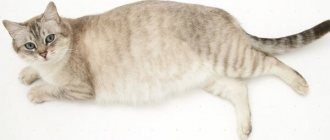The main reasons for falling on your side
It is impossible to independently find out why a cat falls on its side when walking. Requires specialist help and hardware research. First of all, the clinic takes blood tests. Most often this is a general analysis, but in some cases a biopsy is required. Among the most common reasons for a cat’s poor health are the following factors:
- Epilepsy. A very serious disease in which the brain does not receive the required amount of oxygen. As a result, serious attacks develop. If a cat falls over on its side when walking, this may be the first sign of a serious illness. There are several types of the disease. Some occur in a milder form and do not lead to seizures with the release of foam from the mouth. In any case, the veterinarian will do an X-ray, ultrasound and MRI of the brain, as well as other parts of the body. Only after the diagnosis has been determined can adequate treatment be prescribed. As a rule, this is supported by therapy that will reduce the risk of developing epilepsy and prevent the death of the animal. The disease cannot be completely cured;
- Stroke. Another severe process in which the brain suffers, including the departments responsible for coordination and balance - the cerebellum and the middle part of the ear. The stroke condition develops in different ways. This could be a narrowing of blood vessels in the brain, or it could be a rupture or blockage. In the latter case, the disease leads to the death of the animal or paralysis. Treatment is carried out systematically, including drugs that thin the blood, dilate blood vessels, and support the functioning of the heart. It is very important during the treatment period to maintain proper feeding and undergo regular examinations by doctors;
- Dystrophy of muscle tissue. The disease manifests itself as a result of other negative processes in the body. These may be problems with the circulatory system, as a result, the leg muscles do not receive the required amount of nutrients. There may be a limb injury due to a fall. In any case, it is recommended to show the cat to a specialist. The doctor may prescribe some developmental exercises, wearing special fixing splints, as well as massage procedures;
- Paralysis or paresis. At the initial stage of development of these diseases, the cat falls on its side when walking. Treatment should begin as early as possible to avoid severe processes and complete paralysis of the torso. Recovery therapy can only be prescribed by a veterinarian based on the data obtained from tests and studies;
- Ataxia. This is a condition where there is no coordination of movements of different muscle groups in the body. Most often observed against a background of muscle tissue weakness and motor disorders.
Why is the animal trembling?
Tremors are most often observed by owners of small and miniature animals. This is due to their unstable type of nervous system, high excitability or hypothermia. During muscle tremors, metabolic processes in muscle fibers generate heat, so the pet can simply warm itself. This is a common compensatory mechanism not only for them, but also for people.
Imbalance in the processes of nervous excitation (rapid excitability and long-term restoration of physiological rest), which is typical for choleric or melancholic animals, can cause muscle tremors after any stimulus. The trigger may be unexpected joy in the pet, fear, aggression or stress.
Increased excitability also develops in a state of physical fatigue. Separately, senile tremor in dogs and cats is identified as an adequate phenomenon.
In any case, the appearance of atypical behavior in an animal is a signal to contact a veterinarian. Owners may not always notice the accompanying symptoms or interpret them incorrectly. More often, the pathological condition does not give serious visible clinical signs at all.
Pets with prolonged and regular shivering should undergo a full neurological examination to rule out life-threatening diseases.
Associated symptoms
Symptoms of diseases can develop in two ways. In the first case it manifests itself immediately and in full, and in the second it manifests itself gradually with an intensifying effect. In any situation, you need to seek help from a specialist as soon as possible. Among the most common symptoms are:
- unsteady gait;
- falling on one side when walking;
- inability to move quickly;
- lack of coordination;
- uncertain behavior in space;
- fear of making a movement;
- gently stepping on one side of the paws;
- pupils of different sizes;
- shifty eyes;
- fainting;
- inadequate reaction to habitual actions;
- With epilepsy, the jaws involuntarily close, convulsions, and involuntary urination.
This behavior is justified by the animal’s fear of falling, dizziness, pain in the brain and heart, as well as in the limbs. The development of paralysis can begin as a result of damage to the body by infection, or an inflammatory process in internal organs and systems, when blood flow is disrupted. If parts of the spinal column are disturbed, then the owners often note a disturbance in the bowel movements of the bladder and intestines. The development of ataxia can be facilitated by a brain tumor, panleukopenia, chemical poisoning, and skull trauma.
Treatment is prescribed only by a veterinarian based on the diagnosis. In some cases, the animal will be indicated for inpatient treatment with injections and droppers.
Reasons why a cat falls
Paralysis and paresis of the limbs can be associated with infectious and inflammatory lesions, impaired blood supply, spinal cord or brain injury. In this case, the animal will also experience other neurological symptoms (nystagmus, fainting, behavioral disturbances, different pupil sizes). If the spinal cord in the pelvic area is affected, the cat may have trouble urinating and defecating.
The cat's paws may begin to move apart, then the cat may fall over on its side due to tumors of the spinal cord. The same symptoms can occur with alimentary hyperparateriosis.
Muscle weakness can be caused by various myopathies (for example, caused by potassium deficiency), infectious diseases (viral infection, damage to protozoa). For example, muscle weakness is one of the earliest symptoms of botulism in a cat.
An animal may fall from exhaustion or as a result of heavy blood loss. Bleeding may be internal, so it is not immediately diagnosed. At the same time, the cat is lethargic, refuses food, falls asleep, its limbs are cold, the mucous membranes are bluish.
Ataxia (coordination disorders) can be congenital or acquired. There are several types of this disease in cats.
The main ones include:
- vestibular;
- cortical;
- cerebellar;
- sensitive.
With ataxia, the animal has a staggering gait, it places its paws uncertainly, as if it does not know where or how to lower the limb. Often the animal's head is tilted down or to the side. With some types of ataxia, the animal experiences tremor (minor trembling of the body during movement). Ataxia is caused by various disorders (for example, panleukopenia), poisoning (poisons and plant components), head injury and cerebral edema, group B vitamin deficiency (in particular, lack of vitamin B1), and brain tumors. Cerebellar ataxia, caused by hypoplasia of the cerebellar structures, is not uncommon in cats.
A cat may fall and have convulsions due to epilepsy. During a seizure, the animal sharply jerks its limbs, clacks its jaw, and involuntary urination may occur.
As a result of a stroke, the animal may move in a circle, meow loudly in pain, or fall on its side. The cat's behavior is disrupted. Vomiting may occur. The cat may lose consciousness.
A cat may fall on its side as a result of otitis media. Inflammatory ear disease leads to disruption of the vestibular apparatus. In addition, there may be a refusal to eat, and an unpleasant odor may be felt from the auricle. Purulent discharge appears. When trying to examine or clean the ear, the cat meows, gets nervous, and may bite.
Most often the animal falls on its side. With damage to the hind limbs of any origin, stroke, otitis media, the animal’s hind legs seem to tuck under, and the cat falls to the side. With paralysis, the limbs may lie straight and the animal tries to move by moving its front paws. When he gets tired, he lies down on his side, the croup lags behind in a straight position. With myopathies and myositis of the forelimbs, the cat may fall on its front legs.
Causes
There are several reasons that cause ataxia in a pet. They are divided into congenital and acquired. In the first case, the disease is inherited from the parents to the kitten. Pathology can appear from the first days of life or later. The first symptoms appear by six months.
The list of acquired causes includes panleukopenia (contagious agranulocytosis, infectious enteritis, plague) suffered by a cat during pregnancy. The causative agent is parvovirus, similar to the canine virus. However, in cats it is distinguished by selective tropism.
Some forms of ataxia are caused by specific causes:
- Cerebellar is caused by cerebral hypoplasia, encephalitis, meningitis, thiamine or vitamin E deficiency. The cause of the disease can be spider and tick bites.
- Vestibular appears against the background of the development of tumors of the skull, ears, due to trauma, infection, vitamin B1 deficiency.
- Sensory pain occurs after blows, falls, spinal injuries, intoxication of the body, or due to diabetes.
Other acquired causes of ataxia include head injuries, falls, collisions, and bites received during fights. The disease appears against the background of inflammatory processes, edema, brain tumors, and infections. Ataxia can be caused by severe poisoning with chemicals or heavy metals.
How to help your pet?
If any, even subtle, changes appear in the cat’s gait, or if she begins to miss when jumping, walk “like a drunk,” and especially fall to the side, she needs to be taken to the veterinarian. Gait disturbances and falls are most often a sign of a serious illness, and delay can be fraught with death for the pet.
You should not wait until the animal’s gait returns to normal or amuse yourself by looking at your pet’s clumsy attempts to move.
It is not the cat’s fall itself that requires treatment, but the cause that causes it.
If there is a lack of thiamine, it is necessary to harmonize the animal’s diet; in case of cerebral edema, diuretics are prescribed. If there is blood loss, the animal may need a blood transfusion, and if there is internal bleeding, surgery may be necessary to eliminate the cause of the bleeding.
There is no treatment for hereditary diseases leading to coordination disorders. For brain tumors, surgery or chemotherapy may be recommended. For malignant neoplasms, the prognosis is unfavorable.
Infectious diseases require specific treatment. For bacterial pathology, antibiotics are used. For a viral infection, complex treatment is required. Any disease requires proper treatment. In most cases, it is impossible to help a cat on your own.
What diseases can tremor indicate?
Functional disorders of excitability can be caused by a number of pathologies of the nervous system:
- infectious diseases (adenovirosis, parvovirus enteritis, canine distemper, rabies);
- neoplasms;
- head injuries;
- poisoning
Advanced cases of helminth infestation in animals can also give rise to nervous symptoms, as parasitic worms release toxic decay products into the pet’s body. In this case, typical poisoning develops against the background of “worms.”
Diseases of an infectious nature are excluded by regular vaccination, as well as treatment for external and internal parasites. These pathologies are much easier to prevent than to treat. Remember that some viral diseases in pets cannot be treated! Follow the recommendations of veterinary specialists regarding vaccinations.
The cat cannot walk on his own and falls over on his side.
Hello, we have this problem. The cat cannot walk normally for 3-4 days; it “slides” to the left. Initially, he was limping on his left leg, it gave way inward, and now the entire left side seems to be giving out. They started visiting the doctor after Senya became lethargic and inactive. We were told that the problem was in the kidneys, we were given IVs, but the condition did not improve. Then they did an ultrasound, there was nothing wrong. To check, the doctor decided to take a picture of the lungs, it turned out that there was swelling there. Just now we stood in line for an ultrasound of the heart; it turned out that this is very problematic in Moscow. During treatment, vitamins were injected, the condition improved, the cat ate, and seemed cheerful. Then he just started limping on his left leg, we thought that the injection into the muscle was unsuccessful, since we give injections ourselves. But the doctors said it goes away quickly. For a while he began to walk normally, as usual. And then, as I said, I began to collapse. Today everything has completely worsened, he cannot walk independently, only if he is supported on the left side. Refuses to eat. He seems to be able to feel his hind legs, they even checked them with a needle. Sena is 13 years old. Please help, we are very worried about our cat!
Help save the cat! The cat is dying.
Really need some good advice! After suffering from an illness, the cat was vaccinated some time later. After vaccination (on the 3rd day), the cat seemed to have lost his limbs (I can’t call him paralysis, because he still moves them). Side effects on the central nervous system. Stretching of the limbs as if in convulsions (the convulsions themselves are not observed, as the skier stretches out his paws and slides on the linoleum), twitching of the head while lapping up liquid, as if hiccups (but this is definitely not hiccups). The cat has been eating almost nothing for about 3 days (I feed him broth from a spoon), and goes to the toilet once every 1-2 days, “in a small way.” He doesn’t walk or sit on his own, he just lies on his side. He also has difficulty holding his head. The gaze is conscious, purrs. The doctor cannot do anything, the diagnosis is also unclear. Only the words: “I can’t say anything, all I can do is give injections and hope.” I have already stopped calling the doctor (the doctor is one of the best in the city, only good reviews). I don't want to put you to sleep. I believe that if there is even a small chance, it should be used. Help, what else can be done? Below is our entire medical history for professionals: I’ll start from the beginning: we adopted a small kitten (1-1.5 months) at an animal shelter (June 2012). The kitten turned out to be sick. A week later I lost a lot of weight, I was treated for an intestinal infection (the antiviral drug fosprenil, the immunostimulant catasal and the antibiotic I don’t remember the name of). He was cured within a week. October 2012 - the cat refused food. The reasons are unknown, we didn’t keep track, because... at that time the child was in the hospital. During the child’s injury, the cat really experienced stress, hid under the sofa and sat there for half a day. We contacted the veterinarian. The cause of the disease was never found out; a blood test was taken - everything was within the physiological norm. Treatment for about 3 weeks: fosprenil (antiviral), cobactan (antibiotic), catazal (immunostimulant). It seems that the cat has more or less come to his senses. We finished the treatment. A week later, the cat’s eyes “closed” (that is, the inner eyelid closed the eye by approximately 1/3). Back to the doctor. They said: feline herpes. We resumed fosprenil + anandin drops in the eyes and nose. We treated for 2 weeks. The cat did not feel better. Here at the clinic the head doctor (the owner of the clinic) took care of us. The cat has a temperature of 41.2 (normal 38-39). He prescribed an antibiotic (human suspension amoxiclav). Weekly blood monitoring (the blood, by the way, was normal). The cat is on the mend. The cat began to eat, play, in a word, returned to normal life. Treatment was completed on the 20th of December. After 10 days we were given an anthelmintic, and after another 10 days we were given the Multifel-4 vaccination. 2 days after vaccination, the cat seemed to be paralyzed. It felt like he was having a stroke. His legs were in convulsions, at first he walked on high, straight legs (like on stilts). I couldn’t keep my balance, I fell on my side, I could crash into a door frame, I refused to eat or use the toilet. Back to the doctor. Treatment: saline dropper + piracetam + vitamins B1, B6 alternately, + cerebrolysate (all drugs from a human pharmacy). On the 2nd day of treatment, hope was lost, but the treatment was not abandoned. On the 5th day the cat came to his senses. His joy knew no bounds. On the 7th day of illness, the cat again (out of nowhere, one might say) became ill. I pet him, give him a massage, stretch his paws, warm him up, give him injections and IVs. By the way, I have never had a more sincere and intelligent animal in my life. Can you imagine a cat playing hide and seek with a child! Despite all his illnesses, there was never any thought of abandoning him. You never expect a trick from him, he will never do dirty tricks or steal something from the sly. Every morning I wake up and every day I return from work and there is no confidence that he will wait for me...
Sudden loss of coordination in cats. Causes of coordination problems in cats
Vestibular syndrome is a pathology associated with the functioning of the inner ear and leading to impaired coordination of movements in a pet. Most often, loss of coordination in cats occurs at a fairly advanced age; animals over 12 years of age are usually susceptible to this pathology.
Unfortunately, it is almost impossible to find out exactly the reason for the loss of coordination of movement in cats, however, regardless of the provoking factors, the pathology is characterized by severe symptoms. So, most often the animal begins to throw its head to the side, stagger when walking, fall, losing its balance literally out of the blue. Such signs may be accompanied by more rare manifestations - sometimes the cat’s eyes practically run from side to side, as if she cannot concentrate her gaze on one point or is watching the rapid movement of someone invisible.
The vestibular apparatus consists of a huge number of nerve fibers stretching from the brain to the ear canal; the tasks of this conductive bundle include the orientation of the body in relation to the plane of the earth. When the apparatus is dysfunctional, a kind of “imbalance” occurs, as a result of which there is a lack of coordination when the animal moves.
Depending on the location of the damaged nerve fibers of the brain, the pathology is differentiated into 2 types: central and peripheral. Based on the type of pathology, the condition of the animal and the results of the diagnostic examination, treatment is prescribed, but more often the central vestibular syndrome can be cured, while eliminating the peripheral one is considered difficult.
The diagnostic program includes studying the pet’s medical history, as well as testing the blood for biochemical composition, but often these measures are not enough to accurately identify the cause, so skull x-rays and MRIs are prescribed.
By the way, in rare cases, insufficient functionality of the kidneys or liver can lead to a lack of coordination, so it would be useful to submit a sample of the animal’s urine for analysis according to Nechiporenko. It should also be taken into account that pathologies such as toxic poisoning and the development of a benign or malignant tumor have similar symptoms.
If the suspicion of vestibular syndrome is confirmed by diagnosis, symptomatic treatment is carried out using common pharmacological drugs. For example, Riabal, No-shpa or Cerucal will help relieve attacks of nausea that develop as a result of “seasickness”; for idiopathic syndrome of the vestibular apparatus, treatment will take a decent amount of time and medications will be selected depending on the cause; surgical intervention is not excluded.
The owner’s task is to ensure that the pet does not harm itself during this period due to the inability to control its body perfectly. Therefore, when visiting the clinic, you need to ask the veterinarian how to make the cat’s life more comfortable at this time and how to protect the animal from the danger of injury.
Often, the symptoms of vestibular syndrome disappear as suddenly as they appeared, after 1-2 weeks, however, in this case, a relapse of the pathology can occur at any time, so it is better to visit the veterinarian at the first signs of impaired coordination of movements.
The pathology is not always treatable - in Burmese and Siamese cats, vestibular syndrome is one of the genetic disorders. Treatment of a genetic disease is impossible, so the animal suffers from incoordination throughout its life or the symptoms disappear spontaneously.
If your cat moves strangely and periodically experiences the urge to vomit, you should not treat it yourself using dubious folk advice. In order not to risk the health of your beloved pet, you should immediately contact a veterinary clinic, where the animal will receive professional assistance whenever possible.
How to play with a kitten
To develop coordination of movements, it is useful to arrange games with “prey” in the form of a toy mouse or other object suspended on a fishing rod with a string. It needs to be moved along the floor or slightly raised above the surface. There is no need to force your pet to reach for a toy; such a kitten does not stand well on its hind legs. Also, do not force your pet to jump, otherwise it may end in a fall.
But throwing movements work well for kittens with ataxia. The animal may ambush the toy. In this case, the kitten usually turns over on its back and grabs the prey with its paws. Developing such movements in a cat is very useful.
We must not forget about games for the development of fine motor skills. Nowadays, there are special puzzles for cats on sale with balls and toys hidden inside, as well as mazes. Such toys are very useful for animals with ataxia, as they help develop the accuracy of small movements.
All educational games must be supervised by the owner. After all, cats with ataxia fall very often.
Cerebellar ataxia
In this case, the motor pathology was provoked either by a genetic factor with a developmental defect in the brain structures, or by a mother cat who developed panleukopenia in late pregnancy.
In kittens, hypoplasia of the cerebellum occurs, which controls coordination and regulates voluntary and involuntary movements.
The unusual nature of the kitten becomes obvious when the babies grow up and begin to move actively. And in some cases, particularly attentive owners can detect violations immediately after birth. Most cats with cerebellar ataxia move sideways or diagonally.
Cerebellar ataxia differs from other types of ataxia: nystagmus - involuntary very rapid movements of the eyes, trembling of the head when the animal is focused on something, and tremor of the back of the body during movement. When the cerebellar vermis is damaged, static-locomotor ataxia develops.
According to the severity, it can occur in mild, moderate and severe form. With mild, falls occur periodically, the cat actively walks and runs; with moderate, movements are not easy for the animal, the cat often falls, but still moves. And the severe degree does not even allow you to get up on your paws.
Unfortunately, the disease cannot be treated. But with proper care, a kitten has every chance of living as long as an ordinary healthy cat. He does not experience any pain, his intelligence is completely preserved, and after the age of 1 year, movements become more coordinated and consistent. If deterioration begins, this only indicates that another neurological disease with similar symptoms has joined the ataxia.
By nature, cats with cerebellar ataxia are very affectionate and friendly. Owners of such animals note their unusual intelligence, close emotional connection and strong affection. Throughout its life, a cat perceives its owner or mistress as a big mother.
Reference!
The same litter may produce kittens with varying degrees of cerebellar damage.
How to make your home safe for your pet
Since there is no effective treatment for cerebellar ataxia, it is very important to protect your pet as much as possible from injury from falls. After all, a lack of coordination will accompany the animal throughout its life. To prevent the kitten from getting hurt, you must follow the following rules:
- It is very important that the floor is not slippery, otherwise the animal’s paws will move apart greatly. Wood flooring should be smooth to prevent your pet from getting a splinter. The ideal surface is carpet. It will be convenient for the cat to move around. You can also cover the floor with rugs.
- It is necessary to remove from the floor all large unnecessary objects that the cat might stumble upon while moving.
- Many cats love to climb on bedspreads and curtains. Such vertical surfaces must be securely fastened. You need to pay attention to the length of your pet’s claws. After all, with their help the animal clings to the fabric. You cannot cut the nails too short, otherwise the pet will not be able to hold on to them. At the same time, the claws should not be allowed to curl and get stuck in the fabric.
- Feeding cats with ataxia should be supervised by the owner. An animal with a movement disorder often splashes water and scatters food. Therefore, bowls should be placed so that the feeding area is easy to clean. After eating, you need to wipe the animal's paws and face.
It is important to remember that with ataxia, independent walks are strictly contraindicated for cats. Such animals can get hit by a car; they cannot defend themselves from aggressive relatives and cannot escape from dogs. However, pets with ataxia usually enjoy movement. They can be walked, but only on a harness.
Vestibular ataxia
The diagnosis is made in two cases: with an affected structure of the inner ear and with tumors of the brain stem or medulla oblongata.
Adult animals over 10 years of age are most susceptible to the disease. The cat has difficulty standing, can walk in circles, or fall over on one side.
The head is either thrown back or tilted towards the affected side. Movements are slow and careful. Concomitant strabismus and nystagmus are often found, and in some cases there is also periodic vomiting.
The appearance of vestibular ataxia is provoked by:
- otitis;
- brain tumors;
- bacterial infections and abscesses of the ear canal;
- excessively intense and traumatic ear cleaning;
- medication overdose;
- use of aminoglycoside antibiotics;
- liver or kidney dysfunction (in rare cases).
Attention!
A cat with an affected vestibular apparatus may periodically sit in a corner with its forehead pressed against the wall. We often see this exact pose of the animal in a series of “funny” photos. Meanwhile, the pet is suffering from a severe headache and is in dire need of veterinary care.
Description
Ataxia is a neurological disease.
Characterized by impaired motor activity of the cat, impaired coordination. However, the pathology does not negatively affect the pet’s memory, skills and mental capabilities. The cat can independently reach the tray or bowl of food. Sometimes the disorder worsens during movement. Then it is difficult for the pet to find its way on its own. Due to lack of coordination, any heights are dangerous for a cat - balcony railings, cabinets, even tables and chairs.
| Types of ataxia | Description of the disease |
| Cerebellar | The structure of the cerebellum and medulla oblongata is affected. |
| Proprioritive | The disease affects peripheral nerves. As a result, muscle sensitivity decreases and involuntary cramps appear. |
| Vestibular | Affects the structures of the inner ear. As a result, the cat cannot determine the coordinates in the surrounding space and does not understand where it needs to move. |
| Spinal | The structure of the spinal cord is affected. As a result, the cat's innervation is disrupted; it cannot feel its paws, especially its hind paws. |
The occurrence of ataxia in a cat does not depend on gender, age or breed. The disease can be primary or secondary (develop against the background of other pathologies).
Treatment on an outpatient basis and at home
The entire treatment regimen for ataxia, if possible and relevant, always directly depends on the root cause of the disease. Therefore, the list of prescriptions and dosages of drugs are never the same, even for the same form. And in this section we will provide only generally accepted medical recommendations in practice:
- Vitamin complexes following the example of Gamavit and especially B vitamins are always required;
- antibiotics will be needed if the cat is fighting an infection;
- diuretics - Furosemide, Veroshpiron - will help in the outflow of excess fluid during cerebral edema;
- in case of damage to the spinal cord (sensitive ataxia) - surgical intervention;
- for intoxication - droppers of saline solutions and glucocorticosteroids;
- severe muscle tremors can be treated with caution with Diazepam;
- Cerebrolysate - to improve cerebral circulation;
- Physiotherapy - UMI, UHF, massage;
- Piracetam, Cavinton and Glycine - to restore cerebral functions.
Important!
Please remember that any information on the Internet is for informational purposes only. Never prescribe medications to your cat without first examining and consulting a veterinarian.
Prevention of ataxia
Despite the fatality of this disease, you still have too many conditions in your hands for a full and healthy life for your pet.
- Eliminate all factors that could cause serious serious injury. It is advisable to limit unsupervised walks on the street. And if you live in a multi-story building, a mosquito net on the windows will simply save the animal’s life.
- If you suspect a traumatic brain injury, immediately take your cat to a veterinary clinic or, at a minimum, immediately consult a doctor by telephone.
- Strictly follow the vaccination schedule against panleukopenia, rhinovirus and leukemia.
- Do not under any circumstances start treatment for otitis media or any inflammation in the ears.
- When planning a mating, pre-examine the cat for panleukopenia.
- During pregnancy, protect her from any contact with other animals.
- When purchasing a kitten from breeders, try to find out in as much detail as possible the course of the mother’s pregnancy and possible genetic problems along the family line.
Reference!
Problematic coordination of movements of a cat with ataxia is very well corrected by physical therapy. Exercise and play with the animal as often and for as long as possible. This not only brings him a lot of positive emotions, but is also a necessity when he is ill.
>Useful video
You can see how ataxia manifests itself in the video:
Laboratory diagnostic methods
Diagnosis begins with a history and external examination of the cat. All past and current diseases and inflammatory processes must be recorded. It turns out what the pet eats and hereditary diseases. The degree of impairment (if there are symptoms characteristic of ataxia) of the nervous system is assessed. Laboratory tests are carried out to detect leukemia, panleukopenia or immunodeficiency virus.
An MRI of the brain may be prescribed, which clearly visualizes neoplasms, edema, hemorrhages and aplasia. X-rays and ultrasounds may also be done. The cat's ears are examined using an otoscope. If infection of the brain or spinal cord is suspected, cerebrospinal fluid is taken for analysis and a bacteriological examination is performed.
What is ataxia?
Without going into details, this is the name for a set of symptoms that imply problems with coordination of movements and body position in space. There are three types of this pathology:
- Cerebellar ataxia in cats is caused by damage to the cerebellum.
- Accordingly, vestibular occurs in cases where something is very wrong with the vestibular apparatus located in the inner ear.
- Sensitive. In some ways it is similar to the cerebellar, only in this case important nerve cords are damaged.
There are different causes of ataxia in cats. Most often, the development of the disease is due to:
- Poisoning with various poisons.
- Hereditary diseases accompanied by degenerative phenomena in the nervous tissue.
- Injuries that occur especially often in March, when loving cats fall from balconies.
- Lack of vitamin B1. This is generally typical for cats: many owners “pamper” them with fresh river fish, which contains the enzyme thiaminase. It destroys thiamine, that is, B1, resulting in ataxia. This is especially noticeable in kittens.
- If the cat is “hooked” on some plants. For example, a large dose of catnip can send a cat into “nirvana” for several minutes. At this time, the pet looks like an inveterate drunkard.
- Traumatic brain injury.
- Tumor.
- Infection. In particular, feline panleukopenia is very dangerous.
- Hydrocephalus or cerebral edema.
Unfortunately, these are not all the reasons. Cerebral hypoplasia is a fairly common hereditary lesion of the cerebellum. This phenomenon develops in almost 70% of cases in kittens whose mother suffered from panleukopenia during pregnancy. In addition, it is possible that this pathology may develop with other infectious diseases that the cat picked up while in an “interesting situation.” Helminths can also help.
In very rare cases, ataxia develops due to lysosomal deficiency. There is such an intracellular organelle called a lysosome. It is needed to dispose of peroxide compounds and other nasty things. If there is something wrong with the lysosomes, all these substances begin to accumulate in the body. This pathology is extremely rare, incurable, and its prognosis is poor.
Symptoms and diagnosis
In general, the symptoms of ataxia in cats are simple. The pet looks like a drunkard, he shakes, the cat cannot walk normally, in severe cases he falls on his side with a roar, just trying to sit down. A constant tilt of the head to one side, as well as erratic circular eye movements, are very typical. Other symptoms may vary depending on the underlying cause of the ataxia. For example, a cat “under mint” can walk with a wobbling gait with its head held high; from time to time, it shakes it and generously splashes saliva around. It looks terrible, but goes away quickly.
Your veterinarian will perform a complete physical examination of your cat. The information provided by the cat's owner is important. It is advisable to remember the following:
- Did the animal have access to household chemicals, poisons, or was deratization (rodent extermination) carried out in your home or area?
- Is there any information in your pet’s pedigree about any pathologies that the cat’s parents suffered from?
- Did the cat fall from the balcony, did it get hit by a bicycle, etc.
It is very important to remember all the cases of illness that your pet has suffered. It is advisable to tell us if you have tried to treat it yourself by “prescribing” any medications.
A blood test is very important, which will allow you to determine whether there is a deficiency of any important micro- and macroelements and vitamins. X-rays and ultrasound are also used, with the help of which tumors, the presence of parasites, and other serious problems are detected.
Treatment
How to treat ataxia in cats? If the pathology is associated with congenital underdevelopment of the cerebellum, then currently no effective treatment methods have been developed. A sick kitten will never be able to move as confidently as healthy animals. However, most owners find it very difficult to come to terms with this situation. How to help the baby?
Treatment of ataxia in cats at home can only consist of developing movements through games. This will be a kind of physical therapy for your pet.










